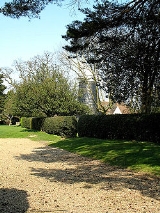
Barnet Gate Mill, Arkley
Encyclopedia
Barnet Gate Mill is a grade II* listed Tower mill
at Barnet Gate
in the London Borough of Barnet
, originally in Hertfordshire
, which was built in 1823.
(c.1800) has not been substantiated. Although steam
had been added in 1895, it was working by wind until 1918, latterly on two sails. The mill was restored in 1930. A new cap, fantail
and gallery around the cap being made. The work was done by Thomas Hunt, the Soham
millwright
. Further restoration in 1985 saw the replacement of the missing pair of sails.
and two Common sails carried on a cast iron
windshaft. The cap is winded by a fantail.
References for above:-
Tower mill
A tower mill is a type of windmill which consists of a brick or stone tower, on top of which sits a roof or cap which can be turned to bring the sails into the wind....
at Barnet Gate
Barnet Gate
Barnet Gate is a small hamlet located on the far outskirts of the London Borough of Barnet, England. It is located in the west hand side of Arkley. It is near to the Stirling Corner junction with the A1. Just to the west is the town of Borehamwood.-Geography:...
in the London Borough of Barnet
London Borough of Barnet
The London Borough of Barnet is a London borough in North London and forms part of Outer London. It has a population of 331,500 and covers . It borders Hertfordshire to the north and five other London boroughs: Harrow and Brent to the west, Camden and Haringey to the south-east and Enfield to the...
, originally in Hertfordshire
Hertfordshire
Hertfordshire is a ceremonial and non-metropolitan county in the East region of England. The county town is Hertford.The county is one of the Home Counties and lies inland, bordered by Greater London , Buckinghamshire , Bedfordshire , Cambridgeshire and...
, which was built in 1823.
History
Barnet Gate Mill was built in 1826. A claim that it was built during the Napoleonic WarsNapoleonic Wars
The Napoleonic Wars were a series of wars declared against Napoleon's French Empire by opposing coalitions that ran from 1803 to 1815. As a continuation of the wars sparked by the French Revolution of 1789, they revolutionised European armies and played out on an unprecedented scale, mainly due to...
(c.1800) has not been substantiated. Although steam
Steam engine
A steam engine is a heat engine that performs mechanical work using steam as its working fluid.Steam engines are external combustion engines, where the working fluid is separate from the combustion products. Non-combustion heat sources such as solar power, nuclear power or geothermal energy may be...
had been added in 1895, it was working by wind until 1918, latterly on two sails. The mill was restored in 1930. A new cap, fantail
Windmill fantail
A Fantail is a small windmill mounted at right angles to the sails, at the rear of the windmill, and which turns the cap automatically to bring it into the wind. The fantail was patented in 1745 by Edmund Lee, a blacksmith working at Brockmill Forge near Wigan, England, and perfected on mills...
and gallery around the cap being made. The work was done by Thomas Hunt, the Soham
Soham
Soham is a small town in the English county of Cambridgeshire. It lies just off the A142 between Ely and Newmarket . Its population is 9,102 , and it is within the district of East Cambridgeshire.-Archaeology:...
millwright
Millwright
A millwright is a craftsman or tradesman engaged with the construction and maintenance of machinery.Early millwrights were specialist carpenters who erected machines used in agriculture, food processing and processing lumber and paper...
. Further restoration in 1985 saw the replacement of the missing pair of sails.
Description
Barnet Gate Mill is a four storey tower mill with an ogee cap which has a gallery. It has two Patent sailsWindmill sail
Windmills are powered by their sails. Sails are found in different designs, from primitive common sails to the advanced patent sails.-Jib sails:...
and two Common sails carried on a cast iron
Cast iron
Cast iron is derived from pig iron, and while it usually refers to gray iron, it also identifies a large group of ferrous alloys which solidify with a eutectic. The color of a fractured surface can be used to identify an alloy. White cast iron is named after its white surface when fractured, due...
windshaft. The cap is winded by a fantail.
Machinery
The mill may have started life with two Common sails and two Spring sails carried on a wooden windshaft as the wooden clasp arm Brake Wheel has had to be fitted with packing pieces to enable it to fit the current windshaft, which being of iron is a smaller diameter that a wooden one would be. The Wallower is of cast iron, carried on a wooden upright shaft. This carries the Great Spur Wheel, which is of iron with wooden cogs and drove the two pairs of millstones underdrift. A third pair was added when steam power was installed. Only one pair of millstones remains today.Millers
- John Whitehead 1843 - 1851
- Frederick Edwards 1870 - 1899
- Noah Edwards 1896 - 1918
References for above:-
External links
- Windmill World webpage on Barnet Gate mill.

